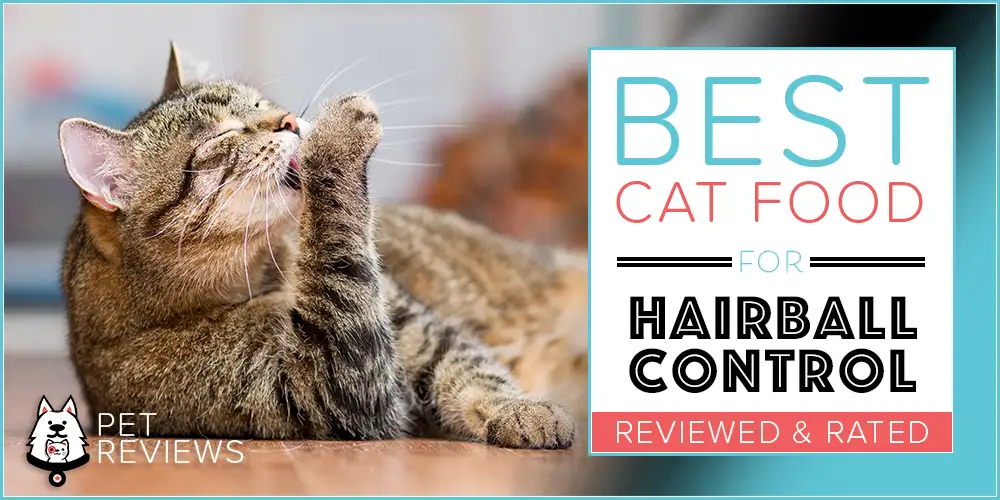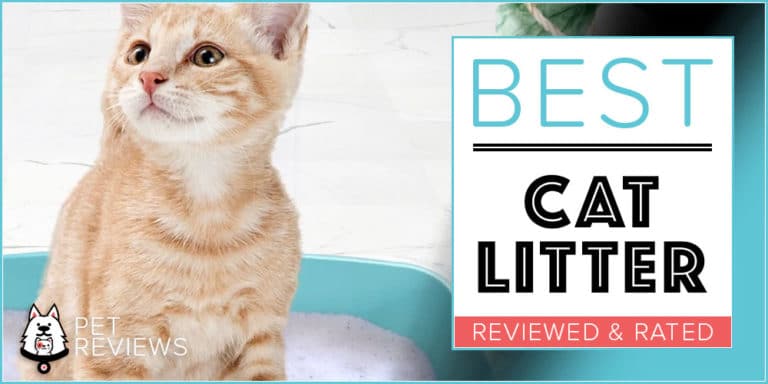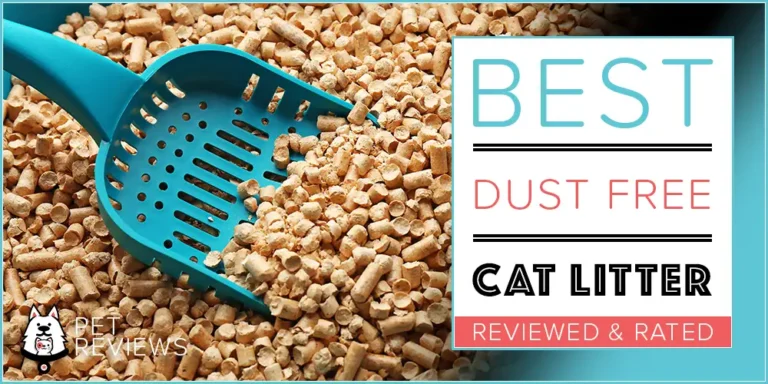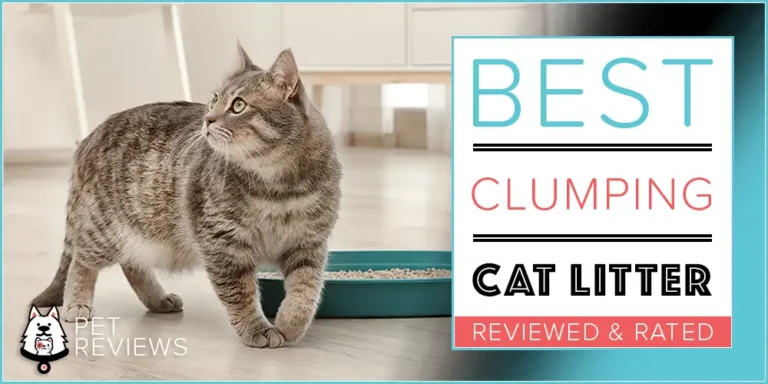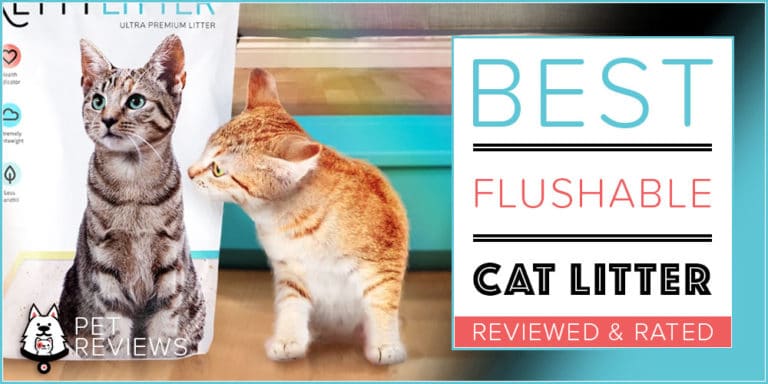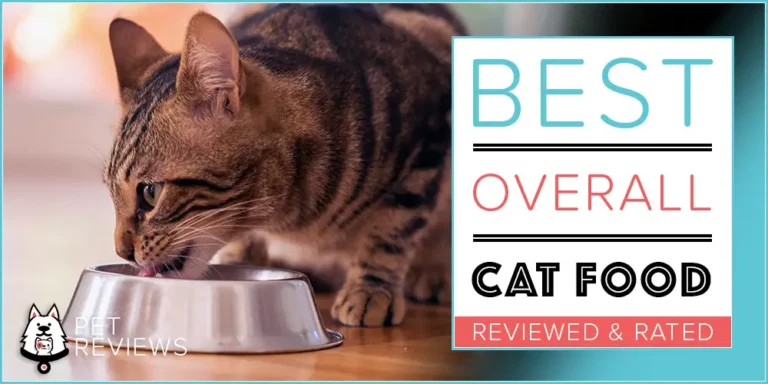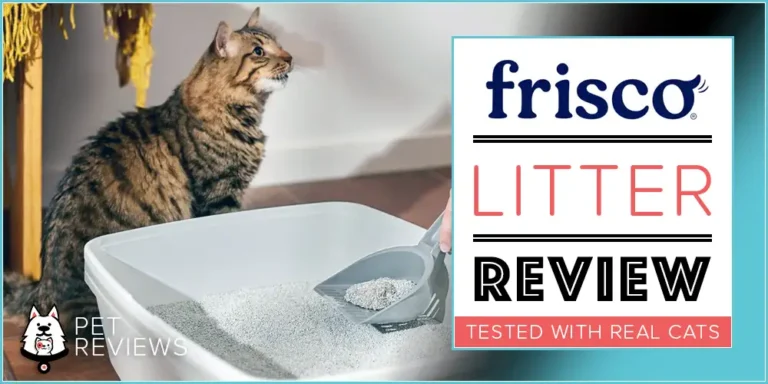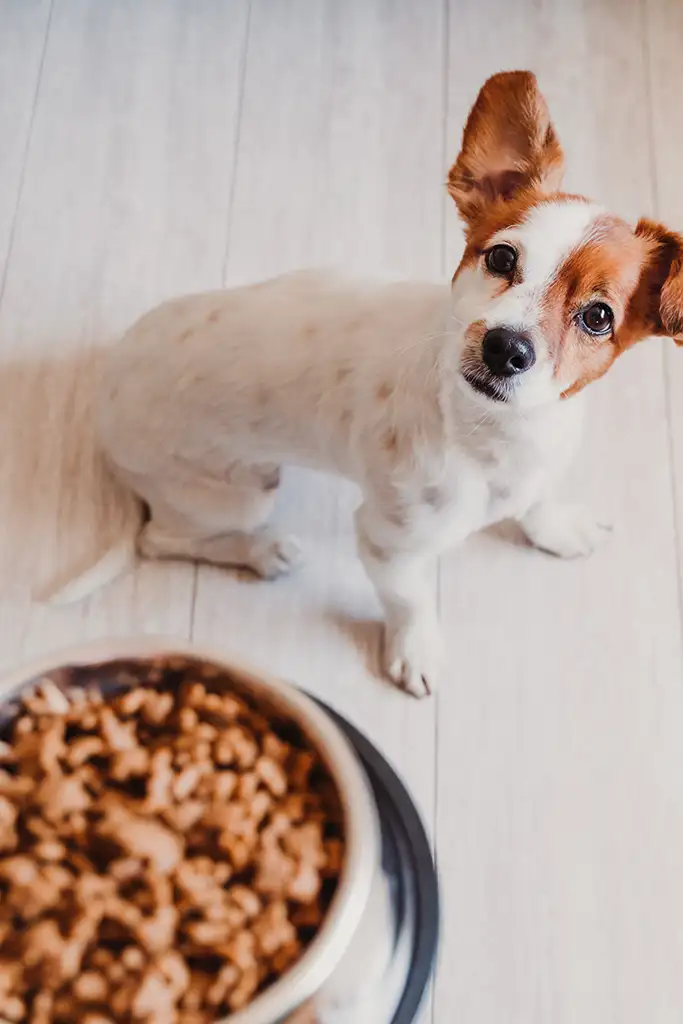10 Best Cat Foods for Hairball Control and Vomiting in 2024
Quick Guide
- What is the Best Hairball Cat Food?
- What Are the Signs and Causes of Hairballs in Cats?
- 7 Things You Might Think Are Hairballs
- What to Look for in a Cat Food for Hairballs and Vomiting
- The Top 10 Best Cat Foods for Hairballs and Vomiting
- Smalls Fresh Bird Human Grade Cat Food Food Delivery Service
- Chicken Soup for the Soul Indoor Recipe with Hairball Care Dry Cat Food
- Blue Buffalo Indoor Hairball & Weight Control Chicken & Brown Rice Recipe Cat Food
- Blue Buffalo Wilderness Indoor Hairball & Weight Control Chicken Recipe Grain-Free Dry Food
- Solid Gold Tropical Blendz with Chicken & Coconut Oil Pate Grain-Free Canned Food
- The Honest Kitchen Grain-Free Chicken Dehydrated Cat Food
- 4 More Top-Rated Cat Foods for Hairballs
- Frequently Asked Questions
- Hairball Control Cat Food – RECAP
Every cat owner knows that coughing, wheezing, retching sound a cat makes when it is coughing up a hairball. If the sound doesn’t make you gag yourself, it probably has you running for a paper towel. If you’re lucky, you can clean up the mess fairly quickly.
Hairballs are a fact of life for most cat owners, but they don’t have to be.
What many cat owners don’t realize is that it isn’t “normal” for cats to frequently cough up hairballs. If your cat is vomiting up hair or any other substance on a regular basis, it could be an indication of a digestive disorder or something more serious. It could also simply mean that you’re not brushing your cat often enough.
Though you can’t stop your cat from accidentally ingesting some of his own hair during grooming, you can take steps to ensure that the hair passes smoothly through his system without causing the upset that leads to a hairball. Making changes to your cat’s diet is one of the best ways to do it.
In this article, we’ll cover the signs and causes of hairballs in cats and briefly touch on some health problems that can disguise themselves as hairballs. You’ll also receive some of our top recommendations for the best cat food for hairball prevention.
What is the Best Hairball Cat Food?
- Smalls Fresh Bird Human Grade Cat Food – Healthiest
- Chicken Soup for the Soul Indoor Recipe with Hairball – Most Affordable
- Blue Buffalo Indoor Hairball & Weight Control Chicken & Brown Rice – Most Popular
- Blue Buffalo Wilderness Indoor Hairball & Weight Control Chicken Recipe
- Solid Gold Tropical Blendz with Chicken & Coconut Oil Pate Grain-Free Canned
- The Honest Kitchen Grain-Free Chicken Dehydrated Cat Food
- Halo Turkey & Duck Recipe Grain-Free Indoor Canned Cat Food
- Nutro Wholesome Essentials Hairball Control Farm-Raised Chicken & Brown
- Wellness CORE Grain-Free Indoor Chicken & Chicken Liver Canned Cat Food
- Wellness Natural Hairball Control Chicken Meal & Rice Recipe Dry Cat Food
What Are the Signs and Causes of Hairballs in Cats?
If you own a cat, you’ve probably found a disgusting wad of hair sitting around and have realized (maybe after accidentally stepping in it) that it’s a hairball. Hairballs themselves are pretty easy to identify, but what are some of the other signs of hairballs?
Here are some of the signs and symptoms of hairballs in cats:
- Persistent coughing or wheezing
- Gagging, hacking, or retching
- Vomiting up hair
- Loss of appetite
- Lethargy, low energy
- Constipation or diarrhea
The most common cause of hairballs is simply that loose hair has been ingested (typically during grooming) but hasn’t passed through the digestive tract. If too much hair accumulates and cannot be passed, the cat vomits it up instead. Sometimes hairballs are a sign that something else is going on in your cat’s digestive system, causing vomiting and other symptoms.
All cats groom themselves and therefore have the potential to develop hairballs. Some cats, however, have a higher risk for hairballs because they have more hair. This includes long-haired breeds like Persians and Maine Coons. Some cats also develop hairballs more often when the weather is warm, and they start shedding their winter coats. This is why you should spend a little extra time brushing your cat in the spring months before summer really starts to set in.
As a cat owner, you learn to recognize the signs of hairballs pretty quickly, but there are some conditions that look and sound like hairballs but aren’t. Keep reading to learn more.
Read Also: Our 2024 Picks for the Best Wet and Dry Foods for Cats
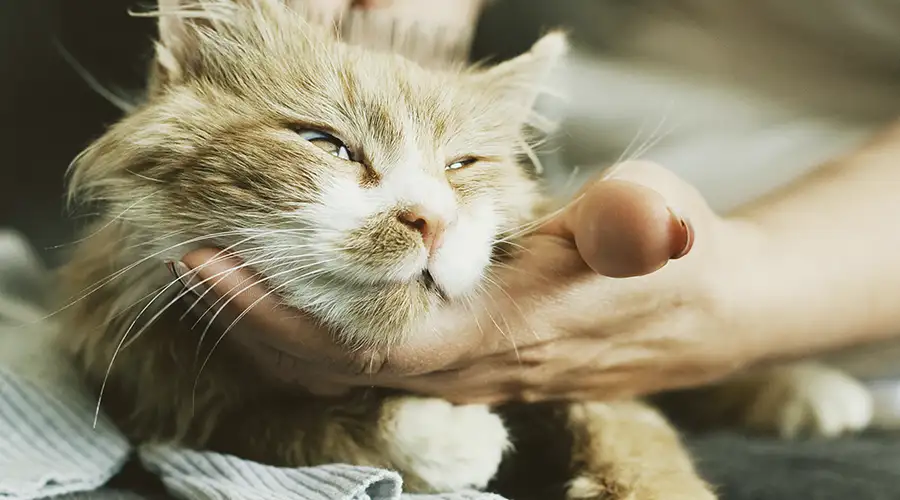
7 Things You Might Think Are Hairballs
If your cat spends a lot of time coughing, wheezing, gagging, or retching, you should probably be concerned. When a big gooey hairball is the result of all this, you might think that you’ve identified the problem when, in reality, frequent hairballs and vomiting could be a sign of a bigger problem.
Here are 7 things that can disguise themselves with the symptoms of hairballs and vomiting:
- Asthma
- Chemical irritants
- Foreign body
- Change in diet
- Digestive disease
- Feline heartworm
- Infection
If you’ve ever experienced difficulty breathing yourself, you may know how your cat feels when he’s wheezing and coughing. Frequent or prolonged episodes of coughing and wheezing are more likely to be caused by asthma or other respiratory conditions than by hairballs. To double check, listen to your cat while he breathes to see if you can detect any wheezing.
In the same way that respiratory conditions can cause chronic bouts of coughing, exposure to chemical irritants can cause episodes of acute coughing. Chemical sprays, powders, and propellants can cause your cat to develop a sharp cough that sometimes sounds like a hairball. A foreign body stuck in the cat’s throat can also cause this kind of hacking cough.
If your cat is vomiting, but it doesn’t always look like a hairball, it could be a reaction to a change in his diet or the result of some kind of disease or infection.
Even if your cat doesn’t have a sensitive stomach, a sudden change in diet can cause digestive upset and lead to symptoms such as vomiting. Similarly, digestive diseases like inflammatory bowel disease, pancreatitis, kidney disease, and gall bladder inflammation can all cause vomiting as well. Feline heartworm is another serious disease, but it actually causes problems in the lungs and can trigger hairball-like coughing episodes.
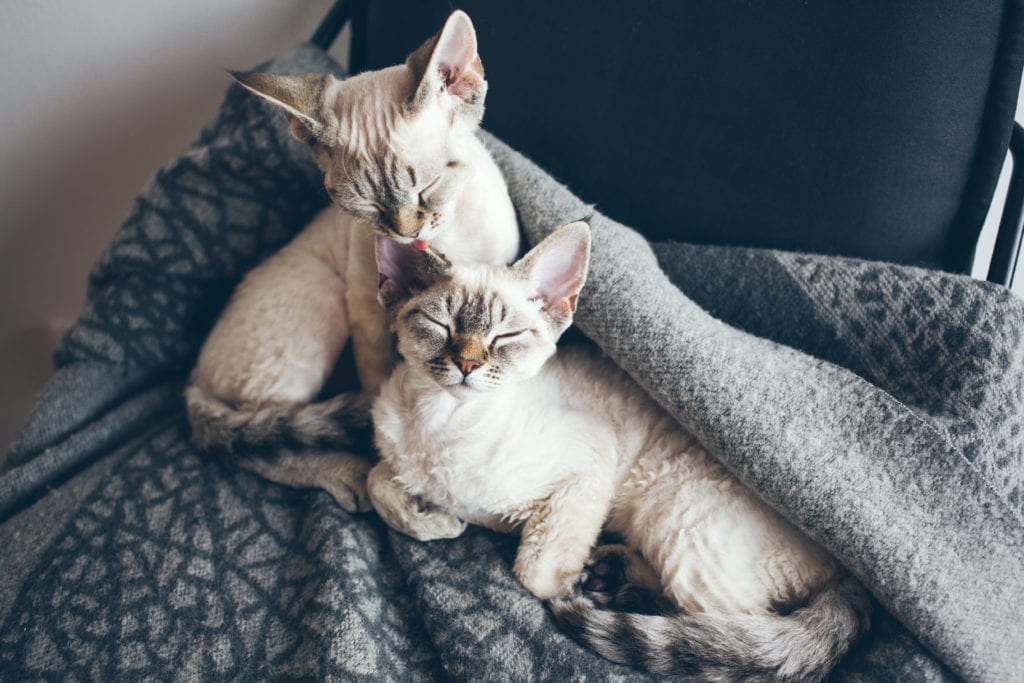
What to Look for in a Cat Food for Hairballs and Vomiting
Vomiting is never a good sign for cats, even if it’s just a hairball. The fact that your cat is vomiting up hair instead of being able to pass it through the digestive tract suggests that something isn’t right.
One of the best ways to reduce hairballs and vomiting in cats is to make changes to your cat’s diet. Your cat’s nutrition is always the top priority, so keep his basic nutritional requirements in mind as you start shopping around. Remember that cats are obligate carnivores, so meat should be the foundation of a healthy diet, and your cat’s food should be free from fillers, by-products, and artificial additives.
Outside your cat’s basic requirements, here are some things to look for in the best hairball cat food:
- Higher Fiber Content – Fiber is essential for healthy and regular digestion, so choosing a high-fiber cat food may help improve your cat’s digestion so he can pass hairballs instead of vomiting.
- Increased Moisture Level – Many cats don’t like to drink water and the more dehydrated they get, the more digestive issues they have. Increasing the moisture content in your cat’s diet can improve his digestion which may make it easier for his body to pass ingested hair.
- Digestible Ingredients – You don’t want to spend time choosing a cat food with extra moisture and fiber just to upset your cat’s stomach with low-quality or indigestible ingredients. Pick a cat food that features premium animal protein as the first ingredient with digestible carbohydrates.
- No Artificial Additives – Artificial colors, flavors, and preservatives provide no nutritional value for your cat, and they are more likely to cause problems than to solve them, especially with your cat’s digestion. The fresher and less processed your cat’s food is, the better.
- Probiotic Supplements – On top of increased fiber and moisture content, choosing a cat food that contains probiotic supplements can improve your cat’s digestion and help pass hairballs.
Generally speaking, the higher the quality of the ingredients in your cat’s food, the more digestible it will be. High digestibility is key when it comes to cat food because if your cat can’t digest the food well, he won’t absorb all of the nutrients. This is why it is important to choose a cat food made with whole food ingredients – especially if your cat is prone to digestive issues. Low-quality ingredients, by-products, and additives can upset your cat’s stomach and make problems like hairballs and vomiting worse.
Now that you have a better understanding of what causes hairballs in cats, you can start taking steps to prevent them. Your first step is to consult your veterinarian and rule out any underlying conditions but, from there, you can start shopping for a hairball control cat food.
The Top 10 Best Cat Foods for Hairballs and Vomiting
The best cat food for hairball prevention will satisfy your cat’s basic nutritional needs using healthy, high-quality ingredients but will also contain plenty of fiber and moisture to support regular digestion. As long as these requirements are met, you can feed your cat whatever you like.
If you’re not sure where to start in shopping for hairball control cat food, we’ve got you covered. Here are some of our top picks for the best hairball formula cat food in different categories:
Smalls Fresh Bird Human Grade Cat Food Food Delivery Service
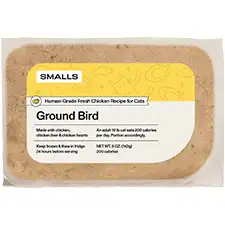
Our Top Pick for the Best Hairball Control Cat food: When it comes to preventing hairballs, healthy and regular digestion is key. Veterinarians and animal nutrition experts agree that fresh food for pets is at the top of the list when it comes to quality nutrition and Smalls is one of the best fresh pet food delivery services out there. When you create a profile for your cat on Smalls’ website, you can input information that will be used to create a custom diet for your cat using one of two proteins – chicken or fish. Both of these recipes are loaded with protein and high in moisture as well as other essential nutrients to ensure healthy, regular digestion as well as complete and balanced nutrition. Though Smalls is not specifically designed for hairball control, quality nutrition and healthy digestion will reduce the frequency of hairballs.
- Pros: Fresh food delivered to your door, high in animal protein, very rich in moisture, premium natural ingredients, perfectly portioned for your cat, no artificial additives
- Cons: Expensive to feed as a staple diet, only two protein options (some cats may be sensitive)
Chicken Soup for the Soul Indoor Recipe with Hairball Care Dry Cat Food
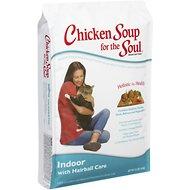
Our Top Pick for the Best Affordable Hairball Cat Food: You don’t necessarily need to spend a lot to find a high-quality cat food that is designed for hairball control. This Chicken Soup for the Soul Indoor Recipe with Hairball Care Dry Cat Food is a great option. Made with real chicken, turkey, duck, and salmon, this recipe is protein-rich and supplemented with fresh fruits and vegetables for nutritional support. It features whole-grain carbohydrates for healthy digestion and carbohydrate energy, plus supplemental sources of fiber for an overall fiber content of 8%. This recipe is rich in omega fatty acids for healthy skin and coat, plus it contains dried fermentation products for probiotic support as well. Overall, it’s a great choice for any indoor cat, but it is particularly beneficial for cats with hairball problems.
- Pros: Formulated for indoor cats, several premium animal proteins, digestible whole-grain carbohydrates, fresh fruits and vegetables, supplemental fiber, beneficial supplements
- Cons: Not a grain-free recipe (some cats may be sensitive), contains some plant protein (pea protein)
Blue Buffalo Indoor Hairball & Weight Control Chicken & Brown Rice Recipe Cat Food
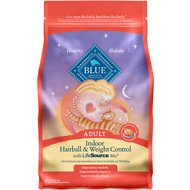
Our Top Pick for the Most Popular Hairball Cat Food: If you’re not sure where to start shopping for hairball control cat food, why not go with a popular recipe like this Blue Buffalo Indoor Hairball & Weight Control Chicken & Brown Rice Recipe Cat Food? This formula is very affordable for the quality it delivers, and it is uniquely formulated for indoor cats, offering both hairball prevention and weight management benefits. This recipe features real chicken as the main ingredient to support lean muscle mass with digestible whole-grain carbohydrates for energy and fiber. It also contains several supplemental sources of fiber for a total crude fiber content of 9%. This formula is rich in omega fatty acids for skin and coat support, plus fresh fruits and vegetables for nutritional balance. It contains probiotics for digestive support as well as chelated minerals.
- Pros: Formulated for hairball & weight control, lean chicken as main ingredient, digestible carbohydrates, fresh fruits and vegetables, supplemental protein sources, rich in omega fatty acids
- Cons: Not a grain-free recipe (some cats may be sensitive), contains plant proteins (pea protein)
Blue Buffalo Wilderness Indoor Hairball & Weight Control Chicken Recipe Grain-Free Dry Food
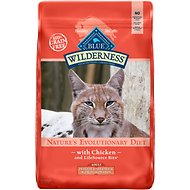
Our Top Pick for the Best Grain-Free Cat Food for Hairballs: Another Blue Buffalo recipe, this Wilderness Indoor Hairball & Weight Control Chicken Recipe Grain-Free Dry Food is an excellent option. This recipe consists of high-protein kibble supplemented with a blend of natural fibers to support healthy digestion and prevent hairballs. It is loaded with healthy nutrients, thanks to the inclusion of LifeSource Bits and it is rich in omega-3 and omega-6 fatty acids for healthy skin and coat. This recipe features lean chicken as the main ingredient with supplemental sources of protein such as chicken meal and turkey meal. It is made with fresh fruits and vegetables to provide natural sources of key nutrients with chelated minerals and vitamins for nutritional balance.
- Pros: High-protein and low-carbohydrate, formulated for hairball control, digestible grain-free carbohydrates, rich in omega fatty acids, fresh fruits, and vegetables, chelated minerals and probiotics
- Cons: Contains plant proteins (pea protein), could be higher in moisture content
Solid Gold Tropical Blendz with Chicken & Coconut Oil Pate Grain-Free Canned Food
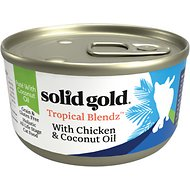
Our Top Pick for the Best Wet Cat Food for Hairballs: If you’re looking for a great hairball control wet cat food, try this Solid Gold Tropical Blendz with Chicken & Coconut Oil Pate Grain-Free Canned Food. Though not specifically designed for hairball control, this recipe features coconut oil as a natural source of medium-chain fatty acids for healthy skin and coat. Plus, it is free from grains and gluten to reduce the risk of triggering food allergies and sensitivities but made with supplemental sources of fiber for optimal digestion. This recipe features fresh chicken as the main ingredient with supplemental proteins like tuna and eggs, plus fresh fruits and vegetables to provide natural sources for key nutrients.
- Pros: Holistic natural formula, real animal protein, digestible grain-free carbohydrates, coconut oil for fatty acids, fresh fruits and veggies, supplemental fiber sources, complete and balanced nutrition
- Cons: Not specifically designed for hairball control, some cats may be sensitive to chicken
The Honest Kitchen Grain-Free Chicken Dehydrated Cat Food
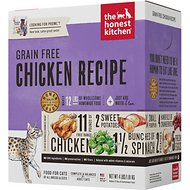
Our Top Pick for the Best Cat Food for Hairballs and Sensitive Stomach: If you’re looking for the best cat food for hairballs and sensitive stomach, a high-quality formula made with no allergenic ingredients and minimally processed is the way to go. This Honest Kitchen Grain-Free Chicken Dehydrated Cat Food is an excellent choice because it supports healthy digestion as well as complete and balanced nutrition, using only the finest natural ingredients. This recipe features fresh chicken as the main ingredient with grain-free carbohydrates including fresh fruits and vegetables for energy and digestive support. Overall, this food contains 39% protein, nearly 30% fat, and over 2% crude fiber. Most importantly, however, it is dehydrated rather than cooked which means that the nutritional integrity of the raw ingredients is preserved. It also means that you can rehydrate it before feeding to maximize your cat’s moisture intake for improved digestion.
- Pros: Dehydrated not cooked, contains 70% chicken, grain-free carbohydrates, whole-food ingredients, fresh fruits and vegetables, chelated minerals, protein-rich and high in fiber
- Cons: Expensive to feed as a staple diet, needs to be rehydrated before feeding
4 More Top-Rated Cat Foods for Hairballs
If none of the cat food recipes reviewed above seem like the perfect fit for your cat, there are still many options for you to consider. You don’t necessarily need to buy a cat food designed specifically for hairballs, either. As long as it is rich in moisture and fiber with plenty of omega-3 fatty acids (and is nutritionally balanced, of course), it could be a good option.
Here are four more top-rated cat foods we recommend for hairball control:
Halo Turkey & Duck Recipe Grain-Free Indoor Canned Cat Food
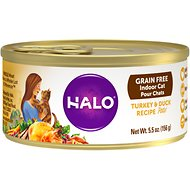
If you prefer to feed your cat wet food, one of the best wet cat food for hairballs options is this Halo Turkey & Duck Recipe Grain-Free Indoor Canned Cat Food. This recipe is formulated for indoor cats, so not only does it help prevent hairballs, but it offers some weight control benefits as well. It features real turkey and duck as the main ingredients, both of which are novel protein sources for many cats. Plus, it contains grain-free, digestible carbohydrates like fresh fruits and vegetables which also provide essential vitamins, minerals, and antioxidants. This recipe is complete and balanced for your cat’s optimal nutrition and rich in natural flavor and moisture, making it nearly irresistible.
- Pros: Formulated for indoor cats, novel protein sources, digestible grain-free carbohydrates, fresh fruits and vegetables, chelated mineral supplements, rich in omega fatty acids
- Cons: Thickened with carrageenan, could be higher in fiber content
Nutro Wholesome Essentials Hairball Control Farm-Raised Chicken & Brown Rice Recipe Dry Food
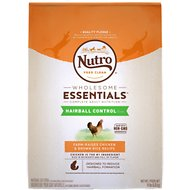
For a high-quality source of nutrition uniquely formulated to prevent hairballs, consider this Nutro Wholesome Essentials Hairball Control Farm-Raised Chicken & Brown Rice Recipe Dry Food. This recipe features farm-raised chicken as the main ingredient with brown rice as the main source of digestible carbohydrates. It contains everything your cat needs for optimal nutrition including plenty of omega fatty acids for healthy skin and coat plus supplemental fiber for healthy digestion. This recipe is completely free from GMO ingredients and artificial additives but supplemented with vitamins and chelated minerals to ensure optimal nutrient absorption. Overall, it contains 33% protein and 8% fiber.
- Pros: Formulated for hairball control, real chicken as main ingredient, digestible whole-grain carbohydrates, rich in omega fatty acids, supplemental fiber total of 8%, chelated mineral supplements
- Cons: Contains plant protein (pea protein), not a grain-free recipe (some cats may be sensitive)
Wellness CORE Grain-Free Indoor Chicken & Chicken Liver Canned Cat Food
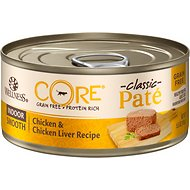
When it comes to hairball control cat food, many cat owners prefer wet food and this Wellness CORE Grain-Free Indoor Chicken & Chicken Liver Canned Cat Food is a great option. This formula is uniquely designed for indoor cats to maintain healthy skin and coat while preventing hairballs. It is 100% grain-free and highly digestible, made with ground peas and cranberries plus supplemental fibers to provide a total of 2% crude fiber and 78% moisture. This recipe is supplemented with chelated minerals to ensure optimal nutrient absorption and is rich in omega-3 and omega-6 fatty acids. It is an excellent source of quality nutrition for your indoor cat with the added benefit of digestive and immune support.
- Pros: Formulated for indoor cats, real chicken as main ingredient, digestible grain-free carbohydrates, rich in nutrients and antioxidants, contains 2% crude fiber, chelated mineral supplements
- Cons: Contains some plant protein (pea protein), fairly expensive to feed as a staple diet
Wellness Natural Hairball Control Chicken Meal & Rice Recipe Dry Cat Food
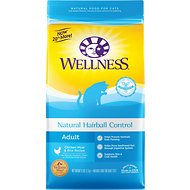
If you’re concerned about the quality of your cat’s diet, this Wellness Natural Hairball Control Chicken Meal & Rice Recipe Dry Cat Food is a great choice. Made with wholesome natural ingredients, this recipe is uniquely formulated for hairball control. It features real chicken as the main ingredient with digestible carbohydrates for energy and fiber. To support your cat’s smooth and regular digestion, it is supplemented with a blend of natural fibers plus prebiotics and probiotics. This recipe is rich in omega fatty acids for healthy skin and coat, plus it is packed with vitamins, minerals, and antioxidants to ensure complete and balanced nutrition. It is made with only high-quality, natural ingredients and is completely free from by-products, fillers, and artificial additives to ensure that nothing upsets your cat’s stomach. Overall, it contains a whopping 36% protein with 16% fat and nearly 6% crude fiber.
- Pros: Wholesome natural ingredients, real chicken as main ingredient, digestible carbohydrates, supplemented with prebiotics and probiotics, blend of natural fibers, rich in protein and healthy fats
- Cons: Not a grain-free recipe (some cats may be sensitive)
Frequently Asked Questions
Can cat food cause hairballs?
To say that cat food causes hairballs seems to suggest that some cat foods contain cat hair which simply isn’t true. Hairballs happen when your cat ingests its own fur during grooming, and that fur doesn’t pass completely through the digestive tract but is vomited up instead. While cat food doesn’t directly cause hairballs, a low-fiber or low-moisture cat food might cause a hiccup in your cat’s digestion that makes hairballs more frequent. Undiagnosed food allergies, digestive disorders, and skin diseases can also contribute to hairballs and be exacerbated by your choice in cat food.
Does wet food help with hairballs?
The question “does wet food help with hairballs” comes from the theory that increasing the moisture content in your cat’s diet will boost his digestion and help him pass hairballs more easily. Whether or not this is actually the case seems to depend on the individual cat, but wet food is certainly a good way to increase the moisture content of your cat’s diet which may help with hairballs.
What is a natural remedy for hairballs in cats?
When it comes to reducing hairballs in cats, there are two ways to approach natural remedies. One approach is to reduce the volume of loose hair in your cat’s coat, so he ingests less hair while grooming. The best way to do this, of course, is to brush your cat more frequently – this is particularly important for cats with very long or thick coats. There are also special anti-shedding shampoos and wet wipes on the market that can help control shedding.
Another approach to reducing hairballs in cats is to increase the fiber content of your cat’s diet and to make other dietary modifications to move hair through the digestive tract, so your cat doesn’t vomit it up. Canned pumpkin is a great fiber supplement because it can easily be mixed into your cat’s food. You can also try over-the-counter fiber supplements like Metamucil or natural options like ground flaxseed. Adding a little olive oil or butter to your cat’s food can also help move things along more smoothly.
Can cats poop out hairballs?
Your cat is bound to ingest some hair while grooming himself and all of that ingested hair has to go somewhere. For many cats, ingested hair is vomited up in the form of hairballs. If your cat’s digestive system is strong enough, however, or if the volume of ingested hair is fairly low, he may be able to pass it normally in his feces.
Can I give my cat fish oil for hairballs?
You may already know the importance of healthy fats in your cat’s diet for skin and coat support, but you may not realize the impact those fats have on hairballs. Sufficient omega-3 fatty acids in your cat’s diet can not only improve the condition of his skin and coat, but it can also boost his digestive health. The healthier your cat’s digestive system is, the better it will be able to manage the hair and other debris he ingests while grooming himself. Fish oil (particularly salmon oil) is an excellent source of omega-3 fatty acids, and you can add it to your cat’s food as a supplement.
Hairball Control Cat Food – RECAP
You can brush and comb your cat all you want, but he is still going to ingest a little hair now and then. The best thing you can do to make sure that the hair doesn’t become a problem is to take steps to improve his digestion. Healthy digestion is the key to smoothly passing hairballs instead of vomiting them up, but it will also boost your cat’s absorption of key nutrients for better overall health. As a reminder, look for a recipe made with digestible carbohydrates and supplemental fiber.
With the information you’ve learned here, you are more than ready to start shopping for the best cat food for hairballs and vomiting. If you’re still not sure where to start, simply pick one of the 10 top-rated cat foods we’ve reviewed above. Good luck!

